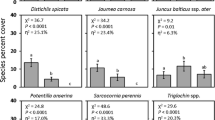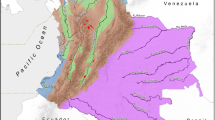Abstract
In order to provide ecologically meaningful recommendations for delimiting coastal wetland (salt marsh) boundaries, we used five approaches to analyze elevation and vegetation data from Bahia de San Quintin, Baja California. The 2-dm elevation band with the steepest slope coincided with the band of lowest compositional similarity and the band with the most species distributional limits. Consistent results, using three analytical approaches, suggest that this band represents an ecological boundary. For Bahia de San Quintín, we suggest that the upper salt marsh boundary coincides with the upper limits ofFrankenia grandifolia,Limonium californicum, andSuaeda esteroa, and the lower limits ofFrankenia palmeri andLycium species.
Similar content being viewed by others
References Cited
Beals, E. 1969. Vegetational change along altitudinal gradients. Science 165:981–985.
Bridges, P. H., and M. R. Leeder. 1976. Sedimentary model for intertidal mudflat channels with examples from the Solway Firth, Scotland. Sedimentology 23:533–552.
California Coastal Commission. 1981. Statewide interpretive guideline for wetlands and other wet environmentally sensitive habitat areas. San Francisco, Calif. 27 pp. plus appendices.
Eilers, H. P., A. Taylor, and W. Sanville. 1983. Vegetative delineation of coastal salt marsh boundaries. Environmental Management 7:443–452.
Harvey, H. T., M. J. Kutilek, and K. M. DiVittorio. 1978. Determination of transition zone limits in coastal California wetlands. Report to Environmental Protection Agency. San Jose State University, San Jose, Calif. 180 pp.
Huffman, R. T. 1981. Technical delineation of wetland boundaries within riparian systems. Unpublished report from the California Riparian Systems Conference, Univ. of California.
Kershaw, K. A. 1973. Quantitative and dynamic plant ecology, 2nd ed. American Elsevier Publ. Co., New York. 308 pp.
Macdonald, K. B. 1977. Coastal salt marsh. In: M. G. Barbour and J. Major, eds., Terrestrial Vegetation of California, pp. 263–294.
Neuenschwander, L. F. 1972. A phytosociological study of the transition between salt marsh and terrestrial vegetation of Bahia de San Quintin. M.A. Thesis, California State Univ., Los Angeles. 70 pp.
Neuenschwander, L. F., T. H. Thorsted, Jr., and R. J. Vogl. 1979. The salt marsh and transitional vegetation of Bahia de San Quintin. Bull. Southern California Acad. Sci. 78:163–182.
Niering, W. A., and R. S. Warren. 1980. Vegetation patterns and processes in New England salt marshes. Bioscience 30:301–307.
Nixon, S. W. 1982. The ecology of New England high salt marshes: a community profile. U.S. Fish and Wildlife Service, Office of Biological Services, Washington, D.C. FWS/OBS-81/55. 70 pp.
Robbins, J. M., and M. J. Hershman. 1974. Boundaries of the coastal zone: a survey of state laws. Coastal Zone Management J. 1:305–331.
Seliskar, D. M. 1983. Root and rhizome distribution as an indicator of upper salt marsh wetland limits. Hydrobiologia 107:231–236.
Thorstad, T. H., Jr. 1972. The salt marsh vegetation of Bahia de San Quintin. M.A. Thesis, California State Univ., Los Angeles. 64 pp.
Whittaker, R. H., editor. 1973. Ordination and Classification of Communities. Handbook of Vegetation Science, Vol. 5. W. Junk, The Hague. 737 pp.
Zedler, J. B. 1977. Salt marsh community structure in the Tijuana Estuary, California. Estuarine Coastal Mar. Sci. 5:39–53.
Zedler, J. B. 1982. The ecology of southern California coastal salt marshes: a community profile. U.S. Fish and Wildlife Service, Biological Services Program, Washington, D.C. FWS/OBS-81/54. 110 pp.
Zedler, J. B. 1984. Salt marsh restoration: a guidebook for southern California. California Sea Grant College Program Technical Report No. T-CSGCP-009. 46 pp.
Author information
Authors and Affiliations
Rights and permissions
About this article
Cite this article
Zedler, J.B., Cox, G.W. Characterizing wetland boundaries: A pacific coast example. Wetlands 4, 43–55 (1984). https://doi.org/10.1007/BF03160486
Issue Date:
DOI: https://doi.org/10.1007/BF03160486




